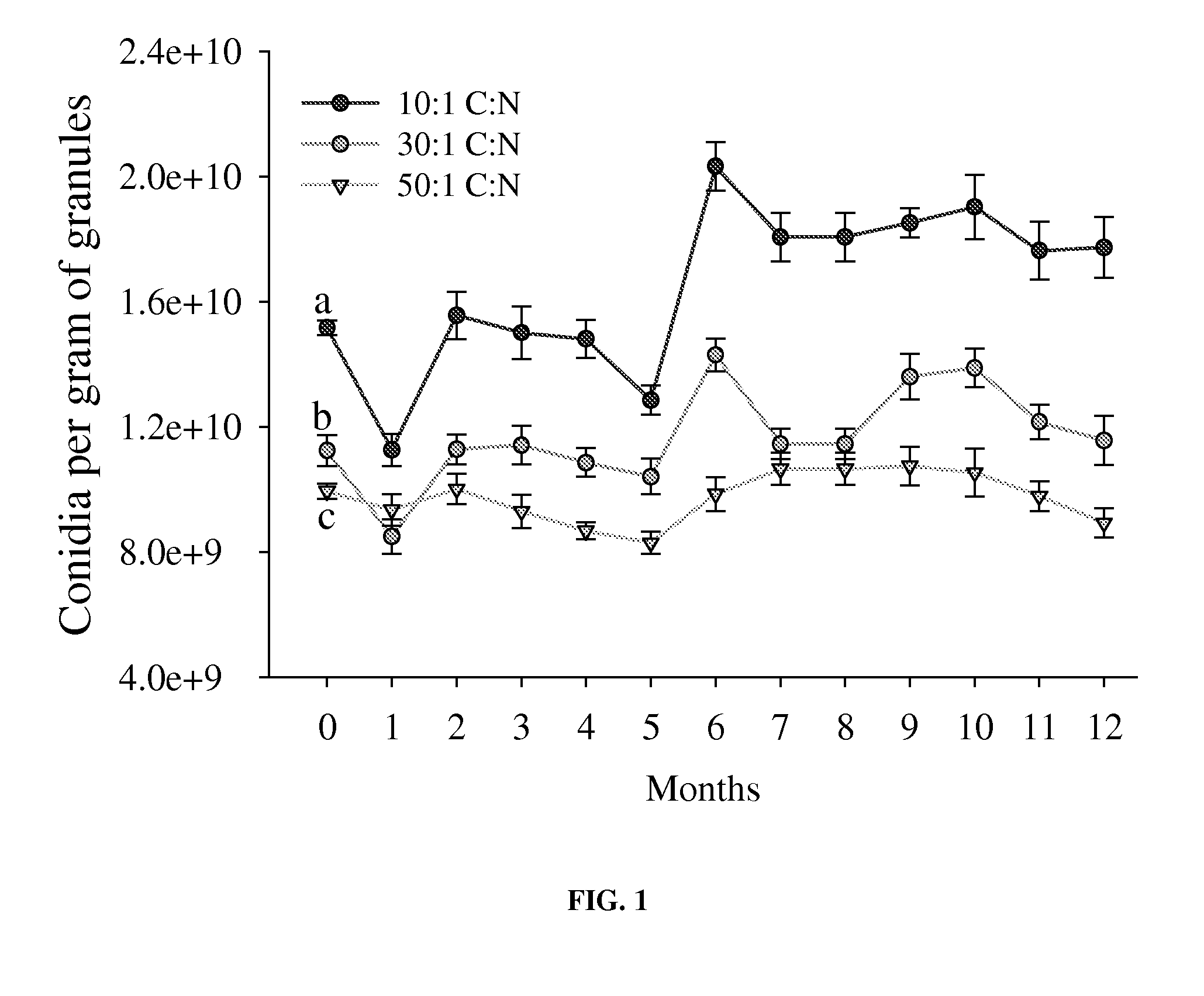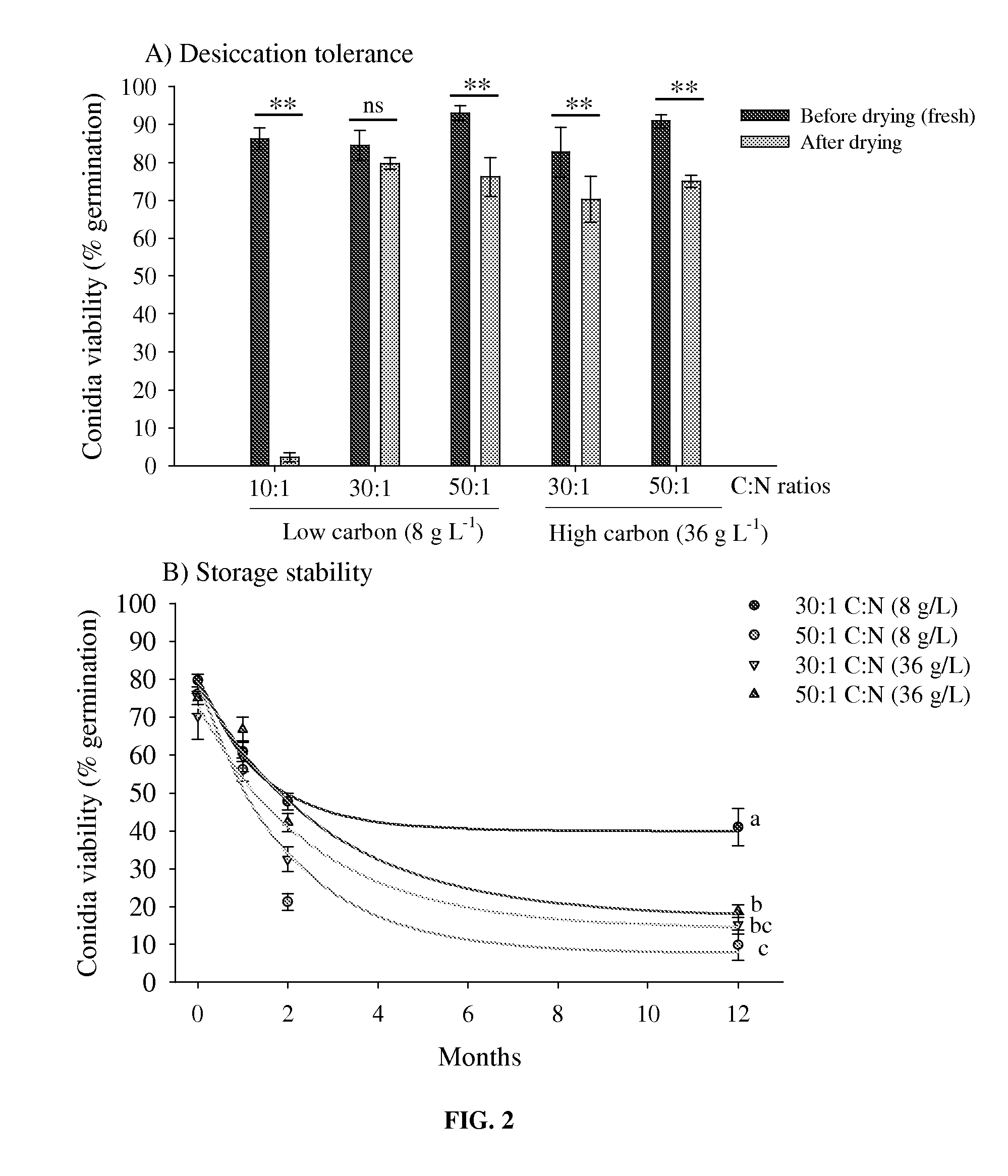Trichoderma compositions and methods of use
a composition and trichoderma technology, applied in the field of trichoderma compositions, can solve the problems of increasing production costs, high labor costs, and increasing production costs of fungal conidia on moistened grains, and achieve the effect of promoting plant growth and effective control of plant diseases
- Summary
- Abstract
- Description
- Claims
- Application Information
AI Technical Summary
Benefits of technology
Problems solved by technology
Method used
Image
Examples
example 1
Formulation, Desiccation Tolerance, and Storage Stability of T. harzianum
[0039]In medium evaluation studies, cultures of T. harzianum strain T-22 as described above were sampled on days 2 and 4 and harvested on day 7. At harvest on day 7, diatomaceous earth [DE (HYFLO®, Celite Corp., Lompoc, Calif., USA)] was added to the fungal biomass of each flask that contained microsclerotia and / or submerged conidia at a concentration of 5 g DE 100 mL−1 culture broth. The culture biomass-DE mixtures were vacuum-filtered in a Buchner funnel using Whatman No. 1 filter paper. The resulting filter cake was broken up by pulsing in a blender (Mini Prep® Plus, Cuisinart, Stamford, Conn., USA), layered in Petri dish plates, and air-dried overnight at ˜22° C. with a relative humidity (rh) of 50-60%. The moisture content of the microsclerotia-DE preparations was determined with a moisture analyzer (Mark II, Denver Instruments, Arvada, Colo., USA) along with their corresponding water activities, measured...
example 2
Effect of Agitation Speed and Nitrogen Sources on T. harzianum T-22 Liquid Fermentation
[0048]Fermentation studies with different nitrogen sources at nutrient concentrations conducive to microsclerotia formation revealed that microsclerotia formation occurred to varying degrees with all nitrogen sources tested (Table 4). Substitution of molasses for glucose as the carbon source inhibited microsclerotia formation. All carbon and nitrogen sources tested at 50:1 (C:N ratio) with 36 g carbon L−1 resulted in the production of both submerged conidia and microsclerotia, with the exception of the molasses treatment that only produced submerged conidia. Increasing the agitation speed from 300 to 350 rpm did not affect the production of submerged conidia (χ2(1)=3.11, P=0.08), microsclerotia yields (χ2(1)=1.06, P=0.302), or biomass accumulation (χ2(1)=2.16, P=0.142). Thus, the experimental data obtained during growth at 300 and 350 rpm were grouped together for analysis. Based on microsclerotia...
example 3
Liquid Culture Production of Microsclerotia of a Plurality of Trichoderma spp.
[0052]A plurality of Trichoderma spp. were tested in liquid culture production of microsclerotia and biomass under shake flask conditions as described in Example 1. These Trichoderma cultures were grown in liquid culture medium 6 (Table 1) using cottonseed flour rather than acid hydrolyzed casein as the nitrogen source. As disclosed in Table 6, a plurality of Trichoderma species were able to form microsclerotia under the stated conditions. After 7 days growth, the microsclerotia were harvested from the culture broth by adding diatomaceous earth (DE) at 5% w / v and filtering under vacuum to remove the spent culture medium. The DE-microsclerotia filter cake was crumbled in a blender and air dried overnight to less than 5% moisture.
TABLE 6Liquid culture production of microsclerotia by various speciesof Trichoderma using a basal salts medium supplementedwith glucose and cottonseed flour. Cultures grown for 7 da...
PUM
| Property | Measurement | Unit |
|---|---|---|
| concentration | aaaaa | aaaaa |
| concentration | aaaaa | aaaaa |
| temperatures | aaaaa | aaaaa |
Abstract
Description
Claims
Application Information
 Login to View More
Login to View More - R&D
- Intellectual Property
- Life Sciences
- Materials
- Tech Scout
- Unparalleled Data Quality
- Higher Quality Content
- 60% Fewer Hallucinations
Browse by: Latest US Patents, China's latest patents, Technical Efficacy Thesaurus, Application Domain, Technology Topic, Popular Technical Reports.
© 2025 PatSnap. All rights reserved.Legal|Privacy policy|Modern Slavery Act Transparency Statement|Sitemap|About US| Contact US: help@patsnap.com



